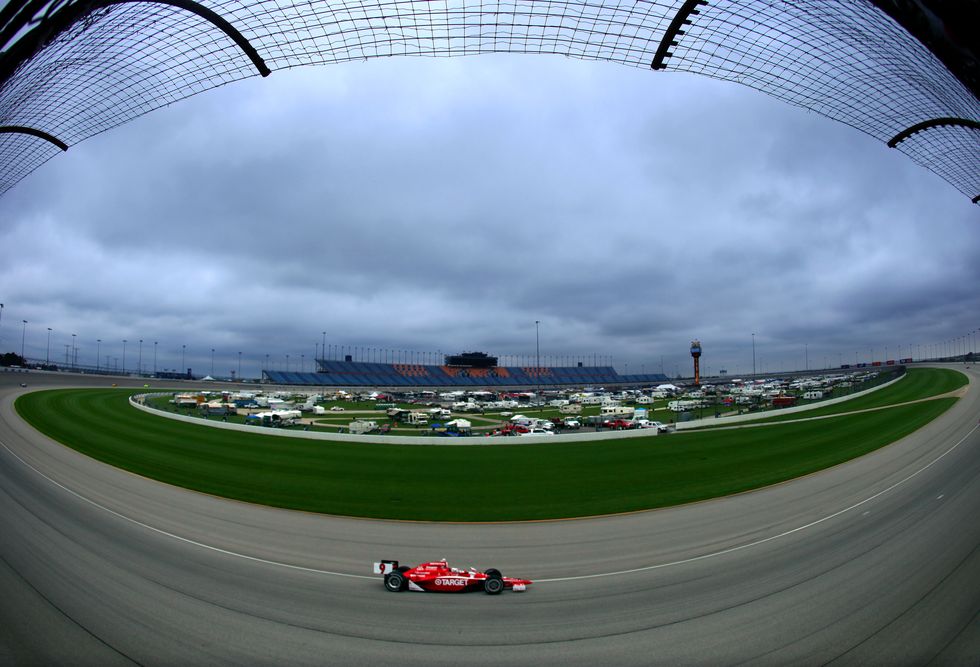- These days,little is heard in NASCAR circles about the giant racetrack an hour southwest of Chicago.
- Chicagoland Speedway opened in 2001 as the newest NASCAR outpost in the Midwest.
- Chicagoland hosted the Cup Series from 2001 to 2019 (and IndyCar from 2001 to 2010).
As publicity continues to flow from all corners of the NASCAR universe about its revolutionary July 1-2 race weekend on the streets of Chicago, little is heard about the giant racetrack an hour southwest of town.
Chicagoland Speedway opened in 2001 as the newest NASCAR outpost in the Midwest, its proximity to the Windy City fulfilling a NASCAR desire to land closer to the nation’s third biggest (by population) market.
Land within the shadows of Chicago’s iconic skyscrapers being either unavailable or crazily expensive, Chicagoland was planted in farmland near Joliet. It “jumped” from a landscape otherwise dominated by cornfields. To tie the track to Chicago was a leap similar to the gerrymandering of modern-day politicians.
Nevertheless, the 1.5-mile track opened to great fanfare in 2001, NASCAR president Bill France Jr. placing the speedway at the forefront of motorsports expansion as his sport churned forward. “The construction of a major league racing facility of this magnitude and quality in the Chicago metropolitan market symbolizes the ongoing transformation of auto racing from a narrowly-focused regional competition to a major mainstream sport,” France said. “This type of racing will rival the NFL, NBA and Major League Baseball for fan and sponsorship involvement. We are absolutely thrilled to be here.”
Now, not so much.
Chicagoland hosted the Cup Series from 2001 to 2019 (and IndyCar from 2001 to 2010), but declining attendance—and NASCAR’s wandering eye—put the track’s future in jeopardy as 2020 approached. Then came the COVID pandemic.
Oddly, COVID was a plus in some ways for NASCAR. It forced officials to devise unique approaches to selling and presenting the product, and it funneled federal money for the improvement of North Wilkesboro Speedway, which returned to the schedule. But the pandemic was deadly for Chicagoland. Its scheduled Cup race in 2020 was canceled, and the success of NASCAR’s detours during the virus shutdowns opened the doors for new thinking.
Suddenly, Chicagoland was left as a child of the corn, its racing thunder gone. The track has been closed since 2019, and part of the property has been sold to warehouse developers.
The only racing activity scheduled at the speedway this year is a September visit by the SuperMotocross playoffs.
Will NASCAR ever return? It doesn’t seem like a top-of-the-agenda matter for officials, and even a modest success by the Chicago Street Race could seal the gates at Chicagoland indefinitely.
“With 20 years of history racing at Chicagoland Speedway, NASCAR continues to explore opportunities to continue to drive economic impact at the Chicagoland Speedway property through its investments – both on and off the track,” NASCAR said in a statement. “We genuinely appreciate the support and enthusiasm of our fans in the Chicagoland region. While we currently do not have details on a timeline or specific series, we do plan to bring NASCAR racing back to Chicagoland Speedway at some point in the future.”
Chicagoland wasn’t known for reliably dynamic racing, but it certainly has a colorful, if brief, history.
In July 2004, qualifying for an Xfinity Series race at the track was interrupted when wind lifted a 20-foot inflatable orange – designed to promote a track sponsor – from its anchor and deposited it on the frontstretch.
In September 2002, Sam Hornish edged Al Unser Jr. by .0024 of a second in one of the tightest races in IndyCar history.
The track’s July 2018 Cup race featured a battle between Kyle Larson and Kyle Busch. Busch won the race by passing Larson with a sweeping run that ended with Busch sliding in front of Larson. Dale Earnhardt Jr., apparently on the edge of his seat in the NBC broadcast booth, excitedly described the moment as a “slide job,” bringing a dirt-track racing term to the hard asphalt of NASCAR.
Tony Stewart, who won three Cup races at Chicagoland, scored at the track in 2011 as NASCAR moved the opening race in the playoffs to the Chicago area in search of greater publicity for the first battle in the run for the championship. Winless to that point in the season, Stewart won at Chicagoland and rolled on to take five of the season’s final 10 races on the way to the title.
Read the full article here



